Entries tagged with “Barolo”.
Did you find what you wanted?
Thu 16 Sep 2010
Our wine guru Gary Chevsky enjoyed a tasting event for Italian red and white wines back in August, and shared his views with us:
“At the Chambers & Chambers trade tasting this week, I had a chance to visit and revisit many wines from all over Italy. Gourmet thin-crust pizzas from Lulu restaurant in the SOMA district of San Francisco complemented what seemed like 80-100 wines. About half the wines at the tasting were imported through Dalla Terra, founded by Brian Larky, a very funny dude. But funny is obviously not all he is – because Dalla Terra is a clever concept. They essentially eliminate one of the tiers in a 4-tier wine import distribution system, through their Winery Direct program.
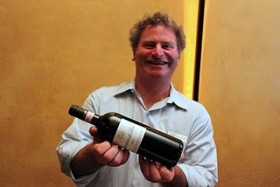 In 1989 Brian returned to the U.S. after five years as winemaker at one of my favorite sparkling wine producers in the world – Italian estate Ca’del Bosco, who makes the top Franciacorta (in Lombardy) that easily rivals top Champagne. Even Ca’del Bosco’s entry-level cuvee “Prestige” is a perennial great value sparkler. Brian founded Dalla Terra Importers in 1990. Before working in Italy, he’d earned a UC Davis Fermentation Sciences degree and held production jobs in Napa Valley wineries such as Far Niente and Domaine Chandon. Don’t be fulled by the effusive smile – the dude is clearly not just a funny dude. Whereas a usual importer markup could be 30-40%, Dalla Terra’s fee is only 15%, and that’s enough for them to run a profitable business for the past 20 years. That’s because unlike a traditional importer who has to buy and hold the inventory from the producer, Dalla Terra are a broker.
In 1989 Brian returned to the U.S. after five years as winemaker at one of my favorite sparkling wine producers in the world – Italian estate Ca’del Bosco, who makes the top Franciacorta (in Lombardy) that easily rivals top Champagne. Even Ca’del Bosco’s entry-level cuvee “Prestige” is a perennial great value sparkler. Brian founded Dalla Terra Importers in 1990. Before working in Italy, he’d earned a UC Davis Fermentation Sciences degree and held production jobs in Napa Valley wineries such as Far Niente and Domaine Chandon. Don’t be fulled by the effusive smile – the dude is clearly not just a funny dude. Whereas a usual importer markup could be 30-40%, Dalla Terra’s fee is only 15%, and that’s enough for them to run a profitable business for the past 20 years. That’s because unlike a traditional importer who has to buy and hold the inventory from the producer, Dalla Terra are a broker.
The concept is relatively common with domestic wines, but quite innovative (and difficult to implement) with imports. They never buy the wine – they connect the winery with a local US state distributor (like Chambers & Chambers), so they never have to shell out the big bucks necessary to hold the wine. Nor do they take the risk of inventory not selling. That is, the risk sits with the winery; therefore it’s reasonable to assume that the winery would retain a larger piece of the pie by quoting a relatively higher price to the distributor than they would to an importer. It’s hard to say though. I went to Wine-Searcher.com – the world’s most trusted wine comparison shopping engine – to compare local US prices to those on the Italian market of some of Dalla Terra’s wines, such as Casanova di Neri and Vietti. I found there is about a 40-50% markup in US over Italy. I then looked at some other high-end Italian producers, such as Il Poggione, Fattoria di Felsina, and Marcarini imported though Southern Wine & Spirits, Wine Warehouse, and Empson USA respectively. US prices were 40% to 125% above the Italian prices. So the price benefits of Dalla Terra were not obvious to me, but this is by no means a scientific study, and I welcome comments from folks in the wine industry. In an interview, Brian told me that Dalla Terra have about 18 producers in their all-Italian portfolio, and in 20 years they haven’t lost one. “That speaks volumes for the type of business partner we are and the type of business we bring.” said Brian.
Here are the wines I particularly enjoyed at the tasting.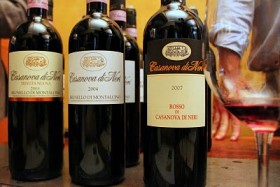
The Reds
Casanova di Neri Brunello di Montalcino 2004. This was their basic “white label” Brunello. (The 2001 Casanova di Neri Brunello made a splash with their higher-end “Tenuto Nuova” cuvee by being Wine Spectator’s #1 wine of the year in 2006.) Had this basic Brunello at the tasting and, more importantly, at a dinner next day. The wine is from the excellent 2004 vintage and is showing very well – juicy fruit, good acidity, tasty tannins. Exploding with aromas and fruit flavors, the wine is light enough to even go with fish, thanks to the excellent acidity and medium body. Delicious.
Marchesi di Gresy Barbaresco “Martinenga” 2006. Sweet, charming, red fruit, beautiful strawberry / cranberry color, gentle Nebbiolo texture, and the most accessible of any 2006 Barbarescos/Barolos I’ve tried so far. 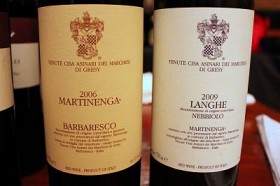
Vietti Barolo “Castiglione” 2006 – structured with slight menthol character, complex. It was the best wine match with the gourmet sausage pizza. The 2006’s are starting to open up. The 2005 “Brunate” didn’t have the menthol, but was also good. Dependable, top producer of Barolo, Vietti’s Barolo Lazzarito 2005 impressed me at the 2010 Tre Bicchieri tasting earlier this year. Their Barbera and Arneis are good too.
Vietti Barbera d’Alba “Scarrone Vigna Vecchia” 2006. Wonderfully balanced, rich, plush Barbera that tips to the much-maligned modern style, yet the delicious factor is undeniable. The most expensive Barbera I’ve ever seen ($75-100 retail). Rare, from a tiny lot in the prime Nebbiolo-caliber vineyard in Castiglione. More of a curiousity item, in my opinion, since in that price range, the wine has to be hand-sold to affluent buyers, looking for something “different”, and will be competing with high-end Barolos and Brunellos. For those who are willing to shell out big bucks for “something different”, there are options in Taurasi (from Campania), Sagrantino di Montefalco (from Umbria), and Etna Rosso (from Sicily) that come to mind before Barbera. Good wine, tough sell. 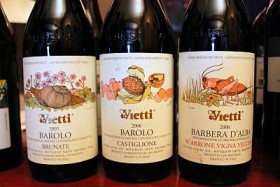
Roccolo Grassi Valpolicella Superiore “Roccolo Grassi” 2007. Single vineyard. Solid.
Roccolo Grassi Amarone “Selezione Antonio Castagnedi” 2006. All three of the Roccolo Grassi wines (including a white, mentioned below) were excellent. A producer to pay attention to. The 16-17% alc. the Amarone didn’t taste hot at all.
Selvapiana Chianti Rufina Riserva “Bucerchiale” 2006 – from a great vintage in Tuscany, excellent structure and texture, medium body. The detractor was notable heat on the palate – and lo and behold, the wine was a whopping (for a Chianti) 14-15% alc.
Cherchi Cannonau di Sardegna Rosso 2009 – good example of the native Cannonau grape of Sardinia. Very drinkable and food-friendly.
Vignalta “Gemola” 2004 – “Super-tuscan” from Veneto! (blend of Merlot and Cab Franc) – flagship of the Vignalta portfolio, well-balanced fruit/veggie, right-bank-Bordeaux like. Liked it both times. Nice effort. 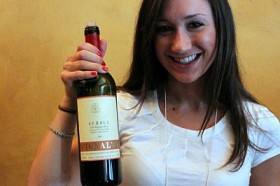
The Whites
Italian whites are a myriad of grape varietals and regions. Generally unoaked or low-oaked, crisp, food friendly, and quite interchangeable. I find Soave (from Veneto), Arneis (from Roero, Piedmont) and Ribolla Gialla (from Friuli) generally to my highest liking. But I enjoy many others depending on the particulars.
Vietti Arneis 2009 – good.
Roccolo Grassi Soave “La Broia” 2007. All three Roccol Grassi’s wines (including two reds mentioned above) were good.
Inama Soave Classico Superiore “Vigneti di Foscarino” 2007. More generous (but tasteful) oak treatment made this wine richer, more complex, more serious than a typical Soave, clearly showing the range of the Garganega grape of which Soave is made. Very good.
Marco Felluga Collio Bianco “Molamatta” 2008. Blend of Pinot Bianco, and the native Tocai Friulano and Ribolla Gialla.
A tasting like this reminds me how much I love Italian wine. And the photos of those pizzas next to the above-mentioned vino make me salivate. It’s almost lunch time here. I’m hungry. How about you?”
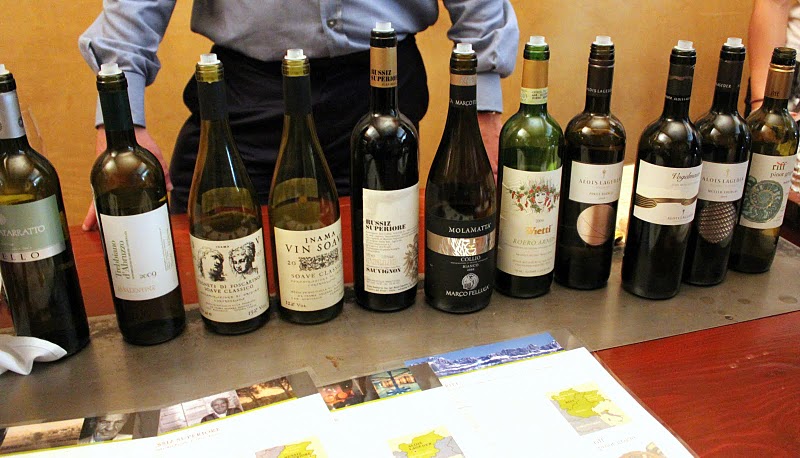
Tags: Amarone, Arneis, Barbaresco, Barbera d'Alba, Barolo, Brunello, Ca'del Bosco, Casanova di Neri, Cherchi, Dalla Terra, Franciacorta, Marchesi di Gresy, Marco Felluga, Piedmont, Roccolo Grassi, Soave, Valpolicella, Veneto, Vietti, Vignalta
Fri 18 Jun 2010
Our wine guru Gary Chevsky visited the annual Gambero Rosso “Tre Bicchieri” event in San Francisco, back in February:
“On Feb 24, one of my favorite trade tasting events of the year arrived to San Francisco. For background on Gambero Rosso and their Tre Bicchieri event, see my coverage of the last year’s event. The world of Italian wine is diverse and complicated. And wonderful. Tre Bicchieri really gives you a chance to sample across the whole of Italy, and to celebrate the variety and the quality all in one place. So without further ado, I will jump straight into my impressions:
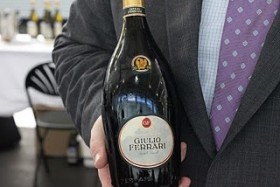
1. The biggest thing that strikes you at an event like this is just how there is always a great new unfamiliar type of wine showing up. This year, I have to give it to Sparkling. The taste and quality of the Italian sparklers is astounding. And I am not talking about Prosecco (which usually leaves me cold). I am talking about Franciacorta DOCG (in the north of Italy, in Lombardy region) and Trento DOC (in the north of Italy, in Trentino – Alto Adige region). These are serious wines made in the traditional method of Champagne. Price is a big problem for these relatively obscure (in the US) appellations, and one more reason why you don’t see a lot of them in this country. Are you willing to shell out $40-100 on an Italian sparker? (After having tasted them, I am!) Here are two of my faves:
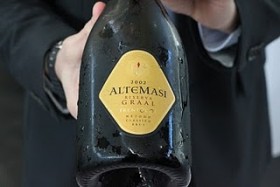 - “Trento Altemasi Graal Brut Riserva 2002” by Cavit – great nose, rich and lush apple syrup;
- “Trento Altemasi Graal Brut Riserva 2002” by Cavit – great nose, rich and lush apple syrup;
- “Trento Giulio Ferrari Riserva del Fondatore Brut 2000” by Ferrari – yeasty, bready, drier and more refined than Altemasi.
I noted them last year as well, but at that time Ca’del Bosco Franciacorta (absent this year) stole my heart.
2. A strong showing for young Amarones this year. Complexity & freshness, rather than an often-seen raisiny fruit. Amarone della Valpolicella Classico Campolongo di Torbe 2004 by Masi (still a year till official release) was ripe, juicy, meaty, spicy and fresh. An honorable mention goes to Guerrieri Rizzardi’s Amarone della Valpolicella Classico Villa Rizzardi 2005 – sweet, slightly herbaceous nose, bitter sweet on the palate.
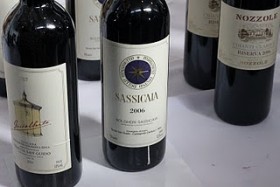 3. I must say the event seemed “poorer” this year, as most of the cult names were not there. I did see Sassicaia. That’s about it. The food was just cheese, crackers, and fruit. Nor did I see the Tre Bicchieri guides or even cork-screws given away like I’d spotted a year ago.
3. I must say the event seemed “poorer” this year, as most of the cult names were not there. I did see Sassicaia. That’s about it. The food was just cheese, crackers, and fruit. Nor did I see the Tre Bicchieri guides or even cork-screws given away like I’d spotted a year ago.
4. Relatively thin showing by Barolo and Brunello reminded me that there are fewer celebrated wines in the most recent release (2005) than a year ago (2004). Only one Brunello stood out for me – Canalicchio di Sopra 2004 – young, fresh and tasty! There were some excellent examples of 2005 Barolo. The charming and talented Giuseppe Vaira delivered on his Barolo Bricco delle Viole 2005 – sweet, soft-textured, intensely flavored, plum, tea, with loads of dark berries. Vietti’s Barolo Lazzarito 2005 was a classic – a powerhouse Nebbiolo, full-flavored, jerky, tannin, serious, young, deep, concentrated black cherry. Several other wines were solid though not amazing – Oddero Barolo Mondoca di Bussia Soprana 2004 (blueberry/cherry tea), Elvio Cogno Barolo V. Elena 2004 (soft and charming), Bezza & Figli Barolo Sarmassa 2005 (toothpasty fresh tea), Travaglini Gattinara Riserva 2004 (meaty and gritty), Prunotto Barolo Bussia 2005 (light & tart), and finally Pio Cesare Barolo Ornato 2005 (herb, spice and blackberry with a unique personality). So long as we are on the subject of Nebbiolo, a notable mention should also go to Ca’del Baio’s Barbaresco Asili 2006 – sweet and tart, slightly spicy, intense and substantive, tannic, with a touch of coffee, poured by the friendly winemaker sisters – Paola and Valentina Grasso.
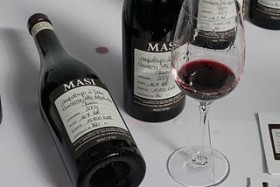 5. Bordeaux varietals and super-tuscans (or Toscana) were all the rage. A lot of good quality Cabs, Merlots, and Bordeaux blends some enhanced with Sangiovese, reminiscent of Bordeaux but with zingier acidity that I so love in Italian wine. The 2006 Bolgheri Sassicaia by Tenuta San Guido was expectedly outstanding (97pts Antonio Galloni, $150 retail) – dusty plum, nice tannins, a slight green component that added to the complexity, very good! The first vintage (2006) of Coevo by Cecchi was excellent too – flavor taking me to the right-bank of Bordeaux, great balance and complexity, 50% Sangio / 10% Cab / 20% Merlot / 20% Petit Verdot, dry blackberries, jerky. Galatrona 2007 (98pts Wine Spectator) from Petrolo, made from 100% Merlot, was a powerhouse gorgeous beast of a wine – veggie and spice, fresh, super-concentrated thick dark berry fruit. If Sassicaia were Pierce Brosnan, the Galatrona was Arnold Schwarzenegger.
5. Bordeaux varietals and super-tuscans (or Toscana) were all the rage. A lot of good quality Cabs, Merlots, and Bordeaux blends some enhanced with Sangiovese, reminiscent of Bordeaux but with zingier acidity that I so love in Italian wine. The 2006 Bolgheri Sassicaia by Tenuta San Guido was expectedly outstanding (97pts Antonio Galloni, $150 retail) – dusty plum, nice tannins, a slight green component that added to the complexity, very good! The first vintage (2006) of Coevo by Cecchi was excellent too – flavor taking me to the right-bank of Bordeaux, great balance and complexity, 50% Sangio / 10% Cab / 20% Merlot / 20% Petit Verdot, dry blackberries, jerky. Galatrona 2007 (98pts Wine Spectator) from Petrolo, made from 100% Merlot, was a powerhouse gorgeous beast of a wine – veggie and spice, fresh, super-concentrated thick dark berry fruit. If Sassicaia were Pierce Brosnan, the Galatrona was Arnold Schwarzenegger.
6. Tre Bicchieri wines (at least all the ones I was drawn to taste) are expensive. Definitely if you want the good stuff, brace yourself — you will pay just as much as for high-end French. I don’t see any obvious “value” categories at the Tre Bicchieri level.
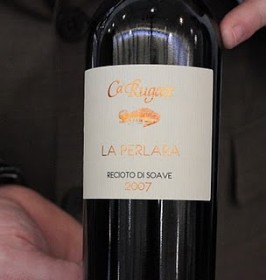 7. Recioto di Soave was a revelation. La Perlara 2007 by Ca’Rugate – a sweet wine of considerable complexity was perhaps the 2nd best Italian sweet white I’d ever had, bested only by the Vin Santo di Montepulciano Avignonesi 1996 from last year’s event. Being more familiar with Recioto di Valpolicella (a sweet red wine), I learned that “recioto” style of winemaking (where grapes are dried on mats for months, vinified somewhere along the way to raisinhood) is also applied to white wine made in Soave from the Garganega grape (in Veneto, in the northeast of Italy, neighboring with Valpolicella).
7. Recioto di Soave was a revelation. La Perlara 2007 by Ca’Rugate – a sweet wine of considerable complexity was perhaps the 2nd best Italian sweet white I’d ever had, bested only by the Vin Santo di Montepulciano Avignonesi 1996 from last year’s event. Being more familiar with Recioto di Valpolicella (a sweet red wine), I learned that “recioto” style of winemaking (where grapes are dried on mats for months, vinified somewhere along the way to raisinhood) is also applied to white wine made in Soave from the Garganega grape (in Veneto, in the northeast of Italy, neighboring with Valpolicella).
8. Some outstanding wines are not imported to California (or the US altogether). The Recioto di Soave above was one of them. Several more that stood out for me were:
a) Franciacorta Saten 2006 sparkler by Il Mosnel - 100% chardonnay, fresh rich lemon custard;
b) Barbera d’Asti Superiore Nizza 2006 by Tenuta Olim Bauda – rich, fresh, balanced, a fairly substantial Barbera; 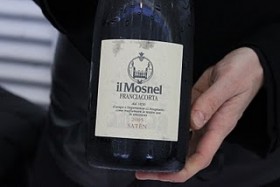
c) Chianti Classico Riserva 2006 by Tenuta di Capraia – good balance, fruit, great acid, nice soft texture/tannin.
After 5 tooth-staining hours of pacing myself through the aisles, I was exhausted. The wines I commented on here, I re-tasted 2-3 times throughout the evening, doing my part in delivering diligent assessment to you, my readers. I know, I know – it’s a tough job, but someone’s gotta do it!”
Tags: Amarone, Barolo, Brunello, Ca'del Bosco, Cavit, Ferrari, Franciacorta, Gambero Rosso, Il Mosnel, Masi, Sassicaia, Tenuta di Capraia, Tenuta Olim Bauda, Tre Bicchieri, Trento DOC, Valpolicella
Thu 3 Jun 2010
Our friend Nancy Yos, of blog At First Glass, kindly shared with us her thoughts on a 2006 Vobis Tua Barbera d’Asti from Cantine Volpi. Nancy has been blogging for three years and her posts cover a wide range of wines and regions.
2006 Vobis Tua Barbera d’Asti
Producer: Cantine Volpi s.r.l., Tortona, Italy.
Light bodied, briny piquancy — tart, underripe raspberries – a little tarry or smoky — needs food
2nd day: mellowed and silkier 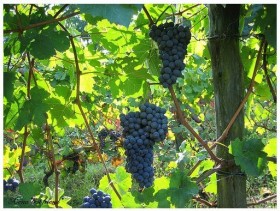
Barbera d’Asti is both a grape and a DOC (Denominazione di Origine Controllata) but note that smaller case b-barbera is the grape, while capital B-Barbera d’Asti refers to the DOC, in the lovely Piedmont region of northwest Italy, spelled in Italian Piemonte. If Italy generally conjures up images of sunshine, rolling hills, Rome, Renaissance art, and pasta, for Piedmont in particular we ought to think instead of mountains (the Alps), rushing rivers (the Po), drifting fogs, of industrial Turin, and oddly enough of rice and corn cultivation. Both are major crops here (think risotto and polenta).
For its part, our glass of Barbera d’Asti represents a sort of little brother in a hierarchy of Piedmont’s red wines, ranking below the great Barbaresco and the still greater Barolo, both named for their places of origin within Piedmont but vinified from the nebbiolo grape — which in turn is named, it seems, for the drifting fogs (nebbia). Barbera can be either Barbera d’Asti, as we have here, or Barbera d’Alba; the latter is considered just slightly more of a heavyweight than the former, which seems to be why Barbera d’Asti is an everyday what’s-for-dinner wine in this part of Italy. Barbera d’Alba is also another DOC.
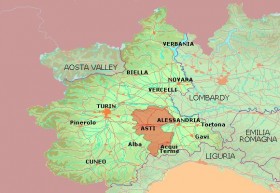 Like so many Italian red wines, except its powerhouse big brothers Barbaresco and Barolo, a Barbera has that tart, light, berry-like flavor and a texture that seems a little grainy and rough, as if a few seeds of a fresh raspberry had found their way into the bottle and added their own little interesting zip there.
Like so many Italian red wines, except its powerhouse big brothers Barbaresco and Barolo, a Barbera has that tart, light, berry-like flavor and a texture that seems a little grainy and rough, as if a few seeds of a fresh raspberry had found their way into the bottle and added their own little interesting zip there.
Wine books always emphasize that Italian wines like this, tending to be thin, fresh, and acidic, are meant to be drunk with a meal and not treated as a free-standing cocktail, which is often how we drink syrupy, barbecued-fruit California cabernets or merlots. Karen MacNeil in The Wine Bible writes rapturously of the Piedmontese food that would go with a Barbera, or even better, with its muscular big brothers, Barbaresco and Barolo: heavy meat dishes, thick risottos, eggy fresh-made pastas dressed only with butter and sage leaves or, if you are lucky and are visiting in the fall, with shavings of white truffle from Alba. The truffle’s spectacular taste, MacNeil explains in a sidebar, has been studied in science labs, and has been found to derive from some sort of chemical that is also present in the testes of men and bulls. Experienced people hunt for them at night in secret, with specially trained white dogs. Wasn’t there a commercial jingle that used to assure us Italians have more fun?
Indeed they seem to, and another of Italy’s most fun wines, Moscato d’Asti, is also a product of this same Piedmont that gives us our very serious Barolos and our zippy Barberas. Of this, I can provide just one quick tasting note: it’s flying off the shelves in grocery stores now, outperforming even queen Chardonnay and princess Pinot Grigio.
Vobis Tua, we are told, is Latin for “as you like it.” We like it. Retail: about $10-$12.
Mon 24 May 2010
Every two years in Turin, Slow Food hosts the Salone del Gusto. This is the mother of all food events and draws over 150,000 visitors. The program for the 2010 event (October 21-25) was recently released (only in Italian) so I wanted to use my blog to highlight this excellent food event.
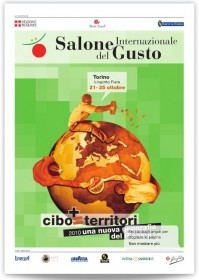 This event is special as the stars of this food expo are the small-scale food producers from all over the world that showcase their products. Moreover, it is about the people just as much as it is about the excellent food as the event enables like-minded producers and buyers to connect in the search for quality food.
This event is special as the stars of this food expo are the small-scale food producers from all over the world that showcase their products. Moreover, it is about the people just as much as it is about the excellent food as the event enables like-minded producers and buyers to connect in the search for quality food.
Visitors can discover and taste Slow Food Presidia products and cuisines from all over the world, attend some of the hundreds of Taste Workshops, participate in conferences and learn from chefs in the Theatre of Taste program.
The program for the event is 50 pages so if there was a specific food/wine etc that you were interested in seeing if there is a workshop on, I suggest you click here to review the program. Also, it is important to highlight that some of the events are not in Turin but in the surrounding Langhe valley.
Definitely worth highlighting is the Sala Slow Wine which is held every day of the event, from 11am to 10pm, with the last entrance at 8.30pm. This consists of an enoteca dedicated to wine lovers who will have the opportunity to choose from 300 well known labels for tastings. Every day international wine makers will host presentations and famous chef Davide Scabin, from Combal.Zero restaurant in Rivoli, will introduce his creations. The €50 ticket gains you access and allows you 15 tastings.
Also, I have highlighted a few workshops that sound yummy but also focus on products around TorreBarolo but as I said, this is only my view and the selection is vast.
L’eredità del Barolo – October 21 at 7pm €45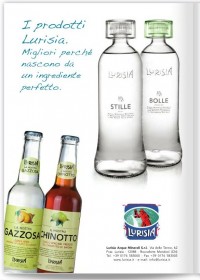
The next generation of 4 of the main Barolo producers present this tasting event, comparing previous vintages, and introducing some new ones: Augusto Cappellano – Barolo Rupestris 2004 and 1998; Roberto Conterno – Barolo Cascina Francia 2006 and 1996; Maria Teresa Mascarello – Barolo 2005 and 1995 (magnum bottle), Pietro Ratti – Barolo Rocche 2007 (preview, though not commercially available until 2011) and 1997.
Barbaresco d’ autore – October 21 at 4pm €30
A retrospective view on the work of Alberto di Gresy, in charge of La Martinega winery in Barbaresco since 1973. The workshop will focus on how he transformed a relatively small family run winery into one of the main Barbaresco labels. Tastings of: Langhe Rosso Virtus 1998, Barbaresco Gajun 1999 e Barbaresco Camp Gros 1990, all in magnum bottle.
Salami d’Italia – October 22 at 4pm €20
Every region in Italy has its own salame. This workshop provides an introduction and overview of the best regional products: salame delle valli tortonesi, salame di Fabriano (Presìdi Slow Food), ventricina del Vastese, fiorettino reggiano, sopressa di Fagagna, finocchiona di San Miniato, soppressata calabra.
I magnifici Novanta di Sandrone – October 22 at 7pm €45 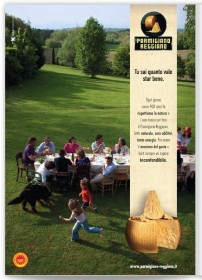
A tasting and tribute to Luciano Sandrone, one of the most celebrated and well-known Barolo wine producers. This event will be extra special as Luciano will personally guide you through some of his best Barolo Le Vigne vintages from the 90s’: 1993, 1995, 1996, 1997, 1998, 1999.
Parmigiano Reggiano e Porto – October 23 at 7pm €25
Two symbols of the best European gastronomy will meet and you will be shown how time changes and affects these products. Four releases of Parmersan (15 months, 22 months, 28 months and the well aged 36 months) will be put together with the best Port, different vintages and types, presented by the Instituto dos Vinhos do Douro e Porto.
If you are interested in participating in any of the workshops etc, I strongly recommend you book way in advance as these events gets sold out well ahead of the opening.
Salone del Gusto is held simultaneously with the Terra Madre world meeting of food communities.
Tags: Barbaresco, Barolo, Cappellano, Combal.Zero, Conterno, La Martinega, Luciano Sandrone, Mascarello, Ratti, Salone del Gusto, SlowFood, Terra Madre
Thu 20 May 2010
I would like to welcome Gary Chevsky, TorreBarolo’s new guest blogger. Gary is WSET-certified and has been blogging for the past three years. He hails from the San Francisco area so many of his posts are about Californian wines, though lucky for me he has a particular passion for wines from the Langhe and Roero region. His wine reviews are informative without being jargon heavy but more importantly he is a man that gets the big picture……to enjoy life and sees the pleasure of a fine wine as one element that contributes to a memorable occasions with friends and family….or as he puts it “This blog is not about wine, but about life – life made better by wine”. I am particularly happy to host Gary’s blog posts as being pregnant these past many months has obviously had an impact on my ability to share my wine suggestions so it is nice to leave all the heavy (glass) lifting to Gary. 
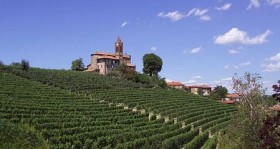 “The other day I had dinner with MariaCristina Oddero – the owner of the Oddero winery, one of the top producers of Barolo, well respected for their dependable quality, and notable for being run by a female in traditionally a male-dominated business. MariaCristina took over from her father Giacomo Oddero in the mid 1990’s, making subtle improvements upon his methods, and according to her, coaxing more complexity from the grapes. Now at 82, Giacomo cannot deny her success, but back then he was not at all supportive.
“The other day I had dinner with MariaCristina Oddero – the owner of the Oddero winery, one of the top producers of Barolo, well respected for their dependable quality, and notable for being run by a female in traditionally a male-dominated business. MariaCristina took over from her father Giacomo Oddero in the mid 1990’s, making subtle improvements upon his methods, and according to her, coaxing more complexity from the grapes. Now at 82, Giacomo cannot deny her success, but back then he was not at all supportive.
They’ve been making wine for 6 generations. The first ever Oddero Barolo was bottled in 1878. A traditionalist, maintaining age-old techniques as exemplified in the modest use of oak (big Slavonian oak barrels) and long maceration times, combined with modern-day equipment and cleanliness, Oddero’s perfume and fruit manage to shine through strong tannic structure at a relatively young age (5 years+).
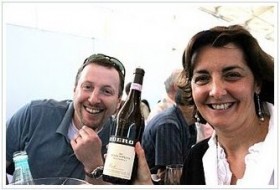 At the dinner hosted at Donato Enoteca, we sampled an array in the most perfect setting imaginable, with great food and good company, without being overwhelmed by multitude of wines or time pressure and fatigue of a trade tasting. A flawless custom-crafted Piedmontese 6-course meal by Donato accompanied 6 wines – a Chardonnay/Riesling blend Langhe Bianco Collaretto 2008, Barbera d’Asti Vinchio 2006, basic Barolo 2005, single-vineyard Barolo Rocche di Castiglione 2005, single-vineyard Barolo Bussia Soprana Vigna Mondoca 2004, finishing off with Moscato d’Asti Cascina Fiori 2008. After the official meal was over, Eric the wine director pulled out Barbaresco Gallina 2005 and Oddero Villero 2005. Under the spell of food and company, the wines served at perfect temperature in perfect glassware to a crowd in damn good mood showed very well indeed, reaffirming the appeal of the 2005 vintage (see my notes from Tre Bicchieri tasting earlier this year).
At the dinner hosted at Donato Enoteca, we sampled an array in the most perfect setting imaginable, with great food and good company, without being overwhelmed by multitude of wines or time pressure and fatigue of a trade tasting. A flawless custom-crafted Piedmontese 6-course meal by Donato accompanied 6 wines – a Chardonnay/Riesling blend Langhe Bianco Collaretto 2008, Barbera d’Asti Vinchio 2006, basic Barolo 2005, single-vineyard Barolo Rocche di Castiglione 2005, single-vineyard Barolo Bussia Soprana Vigna Mondoca 2004, finishing off with Moscato d’Asti Cascina Fiori 2008. After the official meal was over, Eric the wine director pulled out Barbaresco Gallina 2005 and Oddero Villero 2005. Under the spell of food and company, the wines served at perfect temperature in perfect glassware to a crowd in damn good mood showed very well indeed, reaffirming the appeal of the 2005 vintage (see my notes from Tre Bicchieri tasting earlier this year).
The lowly Barbera and Moscato d’Asti were very very good too. As for the Barolos, the wines were solid. The basic 2005 had a fascinating hint of salami on the nose – on special that night for $34 (6-pack pricing), I thought it was the best value. The Rocche was promising, but quite tannic at this point. The Bussia Soprana Vigna Mondoca was a year older (2004), more intense, more open and dark-fruity, while the impressively deep-flavored Villero displayed hints of coffee. I was told that the 2000 Vigna Rionda available for sale ($110) was amazing – supposedly a significant step up from the mid-tier and worth the high price tag, but alas it was not tasted that night.
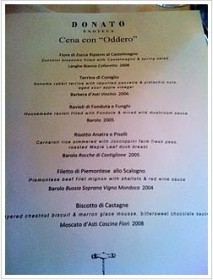 The next day as I attended the Wine Warehouse trade event in San Francisco’s Fort Mason focusing on the new (2006) releases of Barolos, I ran into Mariacristina again. This time I drank her array of 2006’s – the basic Barolo, then Rocche di Castiglione, and finally the Villero. I also re-tasted the 2004 Vigna Mondoca. Oddero’s 2006’s were noticeably more open and less bitter-tannic than all other 2006 Barolos I’d tasted all year, including those from Parusso, Canterno Fantino, Einaudi, and Marcarini. Across the board they have been tough for me to judge due to incredible, hard-as-nails, gum-drying tannins in these young Nebbiolos, although talking to a number of experienced tasters and winemakers themselves, the message has been that 2006 is significantly better vintage than 2005 and more classic than 2004 (2004 shows more fruit while 2006 has more acid, earth, spice and tannin for even longer development). Considering how good the 2004 was, it’s a bold statement for 2006, but at this point I will just have to take their word for it – I could not tell, and will stay away from 2006’s for at least another year until they mellow out somewhat.
The next day as I attended the Wine Warehouse trade event in San Francisco’s Fort Mason focusing on the new (2006) releases of Barolos, I ran into Mariacristina again. This time I drank her array of 2006’s – the basic Barolo, then Rocche di Castiglione, and finally the Villero. I also re-tasted the 2004 Vigna Mondoca. Oddero’s 2006’s were noticeably more open and less bitter-tannic than all other 2006 Barolos I’d tasted all year, including those from Parusso, Canterno Fantino, Einaudi, and Marcarini. Across the board they have been tough for me to judge due to incredible, hard-as-nails, gum-drying tannins in these young Nebbiolos, although talking to a number of experienced tasters and winemakers themselves, the message has been that 2006 is significantly better vintage than 2005 and more classic than 2004 (2004 shows more fruit while 2006 has more acid, earth, spice and tannin for even longer development). Considering how good the 2004 was, it’s a bold statement for 2006, but at this point I will just have to take their word for it – I could not tell, and will stay away from 2006’s for at least another year until they mellow out somewhat.
Interestingly, the 2004 Vigna Mondoca was not as tasty as the day before. Blame it on the setting, on palate fatigue, on the bottle temperature, or lack of decanting, or the glassware…. whatever the reason, this was a telling lesson of how one should be circumspect of the hurried trade tasting impressions. Be mindful of the circumstances in which critics’ scores are given, remember how important the context and setting in which are you consuming wine is, and don’t jump to conclusions too quickly.
Mon 17 May 2010
A couple of weeks ago, I talked about Alba as a classic regional Piemonte town. One reason I am a big Alba fan is due to the numerous foodie and wine events the city host throughout the year. Given TorreBarolo is just a 15mins car ride to Alba, it is easy to get there and enjoy these events for a few hours. Moreover, given the size of Alba, these events are low-key affairs where you don’t have to worry about queuing to sample a selection of wines or walking endlessly around a huge convention center.
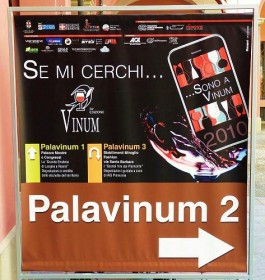 The International White Truffle Fair that commences in October for 2 months is well known and attracts serious foodies given the passion that exists for this mysterious musty smelling fungus. One event that is less well known is Vinum, Langhe and Roreo’s annual wine festival. Vinum’s function is to showcase the mom and pop wineries as well as the regional stars. As many of the smaller wineries don’t export outside the region, I see Vinum as an excellent opportunity to familiarize myself with the vast offerings from the local producers. Also exciting is that the producers use Vinum as the event to release new vintages of Barolo and Barbaresco.
The International White Truffle Fair that commences in October for 2 months is well known and attracts serious foodies given the passion that exists for this mysterious musty smelling fungus. One event that is less well known is Vinum, Langhe and Roreo’s annual wine festival. Vinum’s function is to showcase the mom and pop wineries as well as the regional stars. As many of the smaller wineries don’t export outside the region, I see Vinum as an excellent opportunity to familiarize myself with the vast offerings from the local producers. Also exciting is that the producers use Vinum as the event to release new vintages of Barolo and Barbaresco.
Recently Alba hosted the 34th edition of Vinum and although I was able to attend, being 7 months pregnant did put a damper on being able to enjoy any of the tastings. The set up this year was different than other years I have attended as this year the organizers decided to contain all the events within three separate marquees/exhibition centers. (I must say I preferred this to walking through the streets of Alba looking for the various kiosks).
This year’s three areas were divided into the following: 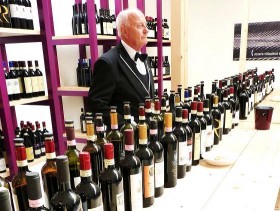
Palavinum 1: hosted the “Grand Langhe and Roero wines”. For €12 you would get a ticket book to taste 10 wines, a wine glass, a pouch to carry your wine glass in, a bottle of water and discount vouchers. For an incremental €4, a 2nd person could join you. Given the quality of wines in this exhibition hall, it looked like a deal to me, especially since I never saw many tickets exchanged and think that as long as you had a pouch and a glass you could go on tasting.
Palavinum 2: hosted both wine and food and was titled “Appetizing Encounters”. The price for this event was the same as Palavinum 1. The difference with this marquee was that the wines weren’t exclusively from the Langhe/Roero region and were from Piemonte in general, however, most of the placards I saw were of local vintners. Given I didn’t recognize many of the wineries in this marquee I am going to make the broad statement that this is where the smaller mom and pop wineries exhibit. Also in this marquee there were numerous food producers offering samples of everything from my favourite Castelmagno cheese, to the special Bra salsicca to the delicious local “Torte alla Nocciola” (hazelnut cakes). 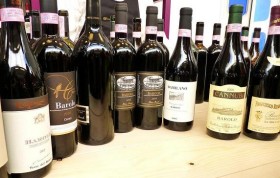
Palavinum 3: hosted the big dogs and instead of kiosks to walk around and sample various wines, there were set times for events and the prices reflected the prestigious wines on offer. For example, there was a retrospective of great Barolo vintages where participates sampled 16 wines for €40. Palavinum 3 events were spread over two days and there were many special events during these days to enhance your knowledge and appreciation of the region’s world famous wines.
Vinum extends over the last weekend in April and first two weekend of May. Mark your calendar for 2011 so you don’t miss out on this excellent wine lover event!

 In 1989 Brian returned to the U.S. after five years as winemaker at one of my favorite sparkling wine producers in the world – Italian estate Ca’del Bosco, who makes the top Franciacorta (in Lombardy) that easily rivals top Champagne. Even Ca’del Bosco’s entry-level cuvee “Prestige” is a perennial great value sparkler. Brian founded Dalla Terra Importers in 1990. Before working in Italy, he’d earned a UC Davis Fermentation Sciences degree and held production jobs in Napa Valley wineries such as Far Niente and Domaine Chandon. Don’t be fulled by the effusive smile – the dude is clearly not just a funny dude. Whereas a usual importer markup could be 30-40%, Dalla Terra’s fee is only 15%, and that’s enough for them to run a profitable business for the past 20 years. That’s because unlike a traditional importer who has to buy and hold the inventory from the producer, Dalla Terra are a broker.
In 1989 Brian returned to the U.S. after five years as winemaker at one of my favorite sparkling wine producers in the world – Italian estate Ca’del Bosco, who makes the top Franciacorta (in Lombardy) that easily rivals top Champagne. Even Ca’del Bosco’s entry-level cuvee “Prestige” is a perennial great value sparkler. Brian founded Dalla Terra Importers in 1990. Before working in Italy, he’d earned a UC Davis Fermentation Sciences degree and held production jobs in Napa Valley wineries such as Far Niente and Domaine Chandon. Don’t be fulled by the effusive smile – the dude is clearly not just a funny dude. Whereas a usual importer markup could be 30-40%, Dalla Terra’s fee is only 15%, and that’s enough for them to run a profitable business for the past 20 years. That’s because unlike a traditional importer who has to buy and hold the inventory from the producer, Dalla Terra are a broker.










 Like so many Italian red wines, except its powerhouse big brothers Barbaresco and Barolo, a Barbera has that tart, light, berry-like flavor and a texture that seems a little grainy and rough, as if a few seeds of a fresh raspberry had found their way into the bottle and added their own little interesting zip there.
Like so many Italian red wines, except its powerhouse big brothers Barbaresco and Barolo, a Barbera has that tart, light, berry-like flavor and a texture that seems a little grainy and rough, as if a few seeds of a fresh raspberry had found their way into the bottle and added their own little interesting zip there.  This event is special as the stars of this food expo are the small-scale food producers from all over the world that showcase their products. Moreover, it is about the people just as much as it is about the excellent food as the event enables like-minded producers and buyers to connect in the search for quality food.
This event is special as the stars of this food expo are the small-scale food producers from all over the world that showcase their products. Moreover, it is about the people just as much as it is about the excellent food as the event enables like-minded producers and buyers to connect in the search for quality food.

 “The other day I had dinner with
“The other day I had dinner with  At the dinner hosted at
At the dinner hosted at  The next day as I attended the Wine Warehouse trade event in San Francisco’s Fort Mason focusing on the new (2006) releases of Barolos, I ran into Mariacristina again. This time I drank her array of 2006’s – the basic Barolo, then Rocche di Castiglione, and finally the Villero. I also re-tasted the 2004 Vigna Mondoca. Oddero’s 2006’s were noticeably more open and less bitter-tannic than all other 2006 Barolos I’d tasted all year, including those from Parusso, Canterno Fantino, Einaudi, and Marcarini. Across the board they have been tough for me to judge due to incredible, hard-as-nails, gum-drying tannins in these young Nebbiolos, although talking to a number of experienced tasters and winemakers themselves, the message has been that 2006 is significantly better vintage than 2005 and more classic than 2004 (2004 shows more fruit while 2006 has more acid, earth, spice and tannin for even longer development). Considering how good the 2004 was, it’s a bold statement for 2006, but at this point I will just have to take their word for it – I could not tell, and will stay away from 2006’s for at least another year until they mellow out somewhat.
The next day as I attended the Wine Warehouse trade event in San Francisco’s Fort Mason focusing on the new (2006) releases of Barolos, I ran into Mariacristina again. This time I drank her array of 2006’s – the basic Barolo, then Rocche di Castiglione, and finally the Villero. I also re-tasted the 2004 Vigna Mondoca. Oddero’s 2006’s were noticeably more open and less bitter-tannic than all other 2006 Barolos I’d tasted all year, including those from Parusso, Canterno Fantino, Einaudi, and Marcarini. Across the board they have been tough for me to judge due to incredible, hard-as-nails, gum-drying tannins in these young Nebbiolos, although talking to a number of experienced tasters and winemakers themselves, the message has been that 2006 is significantly better vintage than 2005 and more classic than 2004 (2004 shows more fruit while 2006 has more acid, earth, spice and tannin for even longer development). Considering how good the 2004 was, it’s a bold statement for 2006, but at this point I will just have to take their word for it – I could not tell, and will stay away from 2006’s for at least another year until they mellow out somewhat. The
The 











